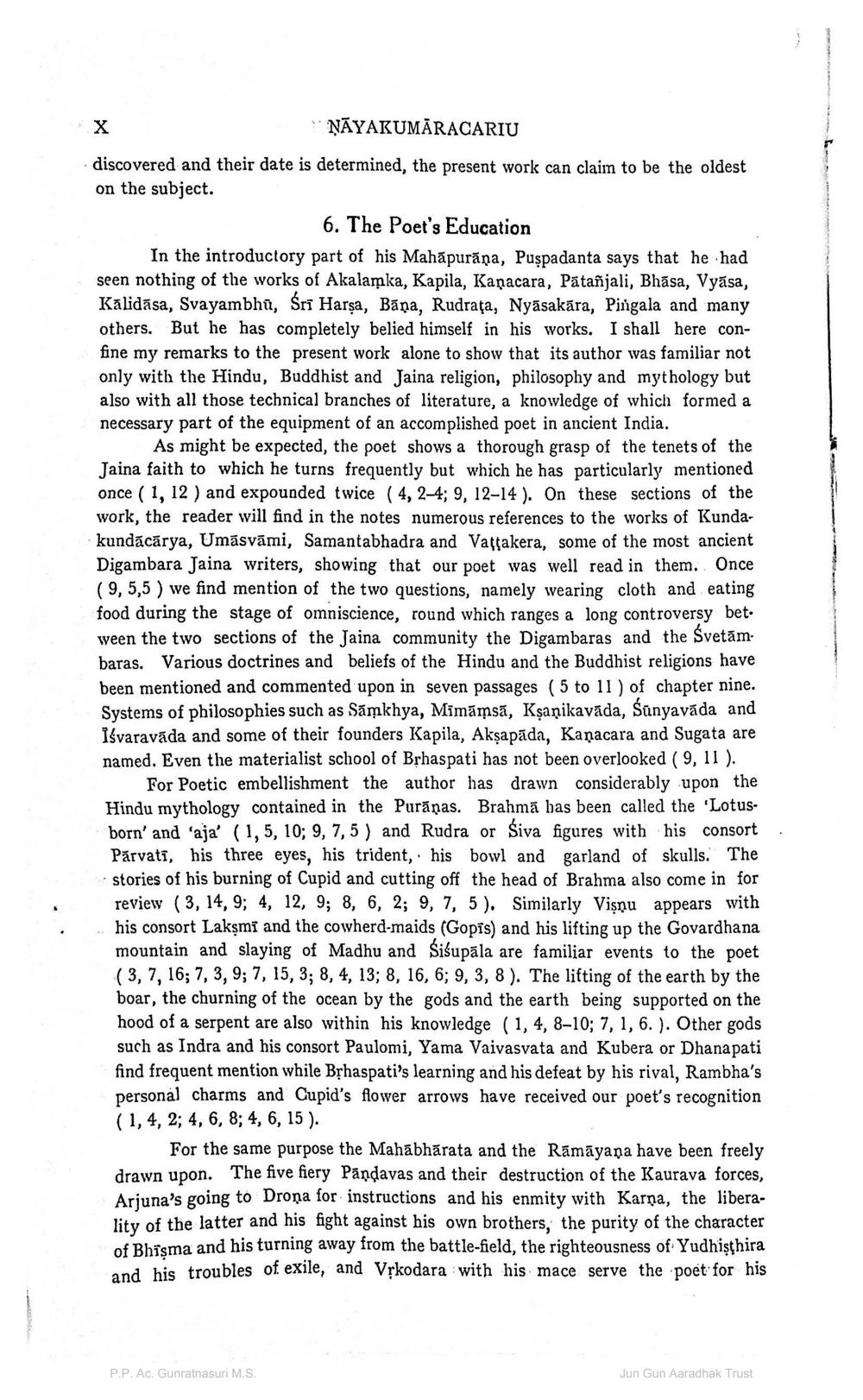________________ X NAYAKUMARACARIU discovered and their date is determined, the present work can claim to be the oldest on the subject. 6. The Poet's Education In the introductory part of his Mahapurana, Puspadanta says that he had seen nothing of the works of Akalamka, Kapila, Kanacara, Patanjali, Bhasa, Vyasa, Kalidasa, Svayambhu, Sri Harsa, Bana, Rudraca, Nyasakara, Pingala and many others. But he has completely belied himself in his works. I shall here confine my remarks to the present work alone to show that its author was familiar not only with the Hindu, Buddhist and Jaina religion, philosophy and mythology but also with all those technical branches of literature, a knowledge of which formed a necessary part of the equipment of an accomplished poet in ancient India. As might be expected, the poet shows a thorough grasp of the tenets of the Jaina faith to which he turns frequently but which he has particularly mentioned once (1, 12 ) and expounded twice ( 4, 2-4; 9, 12-14). On these sections of the work, the reader will find in the notes numerous references to the works of Kundakundacarya, Umasvami, Samantabhadra and Vattakera, some of the most ancient Digambara Jaina writers, showing that our poet was well read in them. Once (9, 5,5 ) we find mention of the two questions, namely wearing cloth and eating food during the stage of omniscience, round which ranges a long controversy bet. ween the two sections of the Jaina community the Digambaras and the Svetam. baras. Various doctrines and beliefs of the Hindu and the Buddhist religions have been mentioned and commented upon in seven passages (5 to 11 ) of chapter nine. Systems of philosophies such as Samkhya, Mimamsa, Ksanikavada, Sunyavada and Isvaravada and some of their founders Kapila, Aksapada, Kanacara and Sugata are named. Even the materialist school of Brhaspati has not been overlooked ( 9, 11 ). For Poetic embellishment the author has drawn considerably upon the Hindu mythology contained in the Puranas. Brahma has been called the 'Lotusborn' and 'aja' (1,5, 10; 9, 7,5 ) and Rudra or Siva figures with his consort. Parvati, his three eyes, his trident, his bowl and garland of skulls. The stories of his burning of Cupid and cutting off the head of Brahma also come in for review (3, 14, 9; 4, 12, 9; 8, 6, 2; 9, 7, 5). Similarly Visnu appears with his consort Laksmi and the cowherd-maids (Gopis) and his lifting up the Govardhana mountain and slaying of Madhu and Sisupala are familiar events to the poet (3, 7, 16; 7, 3, 9; 7, 15, 3; 8, 4, 13; 8, 16, 6; 9, 3, 8). The lifting of the earth by the boar, the churning of the ocean by the gods and the earth being supported on the hood of a serpent are also within his knowledge (1, 4, 8-10; 7, 1, 6.). Other gods such as Indra and his consort Paulomi, Yama Vaivasvata and Kubera or Dhanapati find frequent mention while Bihaspati's learning and his defeat by his rival, Rambha's personal charms and Cupid's flower arrows have received our poet's recognition (1,4, 2; 4, 6, 8; 4, 6, 15). For the same purpose the Mahabharata and the Ramayana have been freely drawn upon. The five fiery Pandavas and their destruction of the Kaurava forces, Arjuna's going to Drona for instructions and his enmity with Karna, the liberality of the latter and his fight against his own brothers, the purity of the character of Bhisma and his turning away from the battle-field, the righteousness of Yudhisthira a his troubles of exile, and Vlkodara with his mace serve the poet for his P.P.AC. Gunratnasuri M.S. Jun Gun Aaradhak Trust




